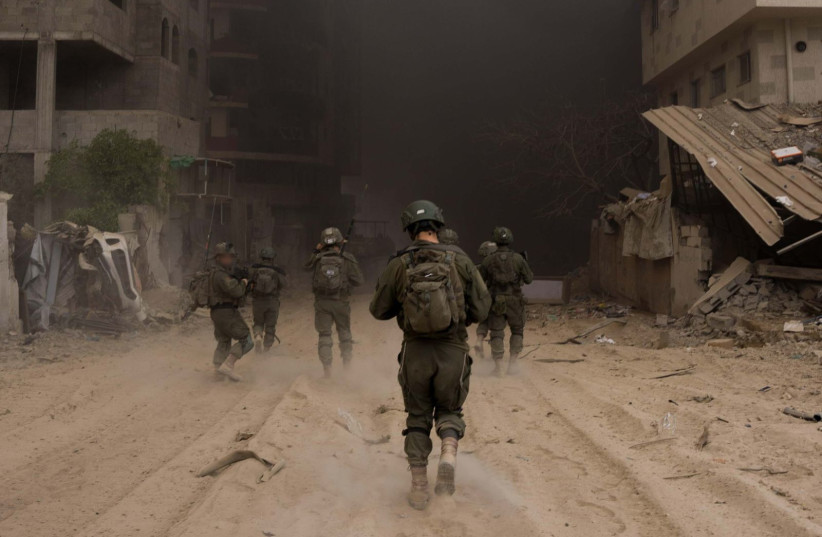On Saturday, the Israel Defense Forces (IDF) reported the demolition of three significant Hamas attack tunnels in the southern Gaza area of Khan Yunis. One of these tunnels extended several hundred meters into Israeli territory and had been monitored by Israeli forces in recent years.
For more stories from The Media Line go to themedialine.org
This tunnel, which the IDF discovered in 2019, was being monitored for Hamas use. "This tunnel was detected by the IDF during the construction of the barrier and since then has been clandestinely under IDF control. Inside the tunnel, IDF soldiers placed explosives and sensors," said Daniel Hagari, IDF spokesperson, during a televised statement on Saturday.
Construction of the IDF's underground barrier concluded in 2021, and the IDF has asserted for years that no more tunnels were penetrating Israeli territory.
Former Deputy National Security Advisor and Vice President of the Jerusalem Institute for Strategy and Security, Dr. Eran Lerman, told The Media Line that he believes the IDF did not publicly announce their knowledge of this penetrating tunnel in an attempt to mislead Hamas in terms of what Israel knows regarding their tunnels.
The IDF spokesperson's statement said that Hamas did not use the tunnel for the Oct. 7 terror attack but added that destroying it is part of Israel's effort to restructure the security measures around the Gaza border. "As part of our renewed assessments for defense in the area of the Gaza Division, we destroyed the tunnel," said Hagari.

Knowing a tunnel exists is not enough to destroy it
Lerman explained that it takes a lot of specific intelligence to destroy these tunnels despite the knowledge of their existence. This is because only Hamas knows their starting and ending points, and they do not uncover these points when the IDF is present in the region. "Therefore, you have to have specific intelligence as to where they begin and go there and destroy them from there," Lerman said, adding that, most likely, the IDF collected those intelligence details during the ongoing ground operation in Gaza.
The IDF discovered the tunnel that penetrated a few hundred meters into Israel in 2019, while the other two tunnels were discovered about a decade ago during the 2014 ground operation.
Prof. Kobi Michael, senior researcher on National Security and the Israeli-Palestinian conflict at Misgav Institute and the Institute for National Strategic Studies, says that although the IDF did not disclose the existence of the tunnels to the public, this does not mean that the Gaza Envelope citizens were not protected from the threat.
"It was sort of a trap that the IDF prepared in advance," Michael told The Media Line. "The IDF posted the explosives and sensors, and once it would be operated by Hamas, the tunnel would have exploded on the head of Hamas operatives. They were under intelligence and technological surveillance," he added.
“Sensors and explosives were placed in [the tunnel] in order to be used by the IDF if needed, as part of a special operation against the underground network of the Hamas terror organization,” said the IDF in a statement.
Lerman added that if there had been an explosion of the tunnel, it would not have caused harm to the people above the ground in the Gaza Envelope. "If Hamas would have tried to use such a tunnel and its people would have been killed there, there would not have been much danger to the people above ground. We know this from former operations," he said.
According to Lerman, the ongoing IDF ground operation in the Gaza Strip has mitigated the threat of the Hamas tunnels penetrating Israel. "Now, given the intelligence that was gained during the operation and the access that Israel has to the immediate perimeter of the border, I think the risk has been greatly reduced," he continued.
Lerman says some tunnels must remain in the Rafah area
However, Michael believes that some tunnels must still remain in the area of Rafah, the only area in Gaza that has not been reached by a full-scale IDF ground operation. "I assume that in the Rafah area, there are some additional tunnels, not in high numbers, along the border," he said, adding that in the Philadelphia corridor, which extends through the Gaza-Egypt border, "there is no doubt that there are dozens of active tunnels," he said.
While speaking about this, Michael stressed the necessity for the IDF to launch an operation in the Rafah area, even if it is not a full-scale ground operation such as it did in the areas of Khan Yunis and Gaza City.
"Hamas still has governmental and military assets in the Rafah area. Therefore, if nothing is done there, it means that Israel will leave the Gaza Strip with a valid anchor for Hamas: a governmental and military core," he said, adding that this anchor will enable Hamas to recover and regroup in the other parts of the Gaza Strip as well.
However, Michael noted that this regrouping would not be on the same scale as it was before Oct. 7. "Israel succeeded in dismantling most of the crucial centers of gravity of Hamas," he explained, but reiterated that Hamas could regain strength if it is left with a stronghold within the Gaza Strip.
